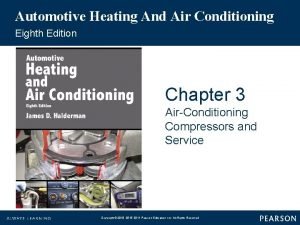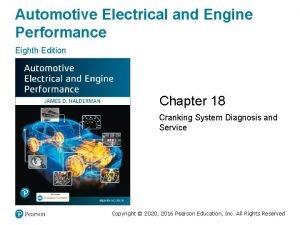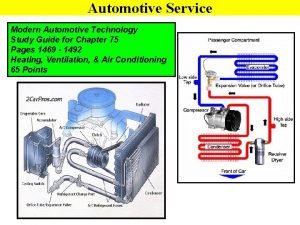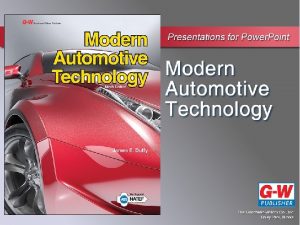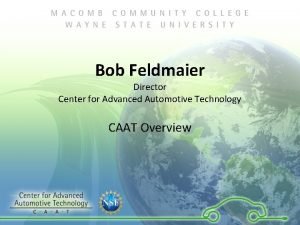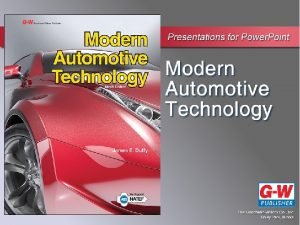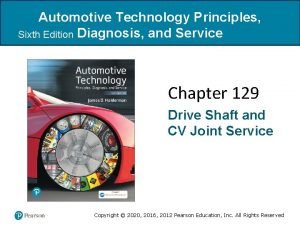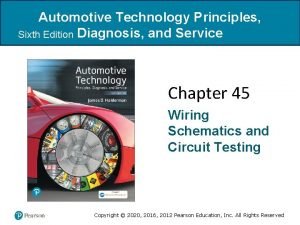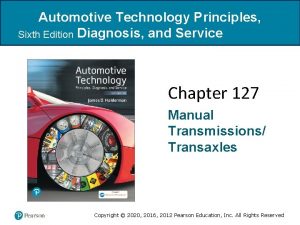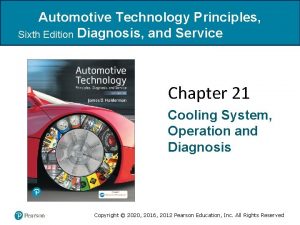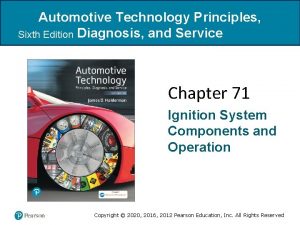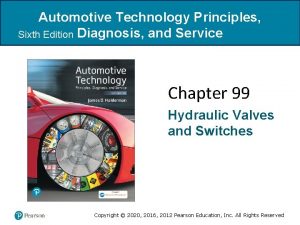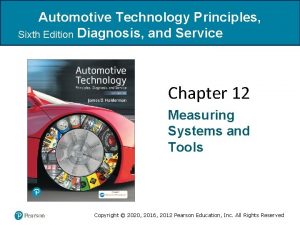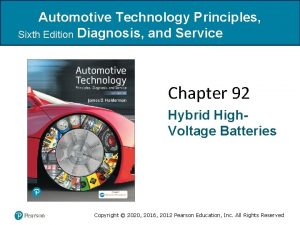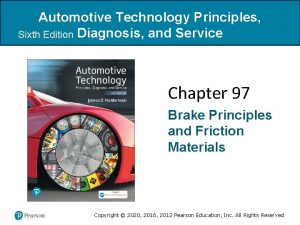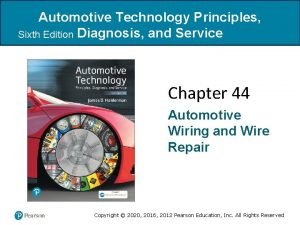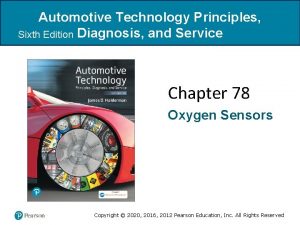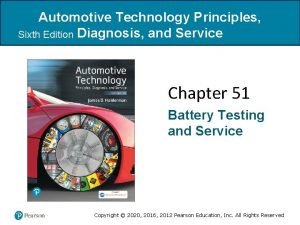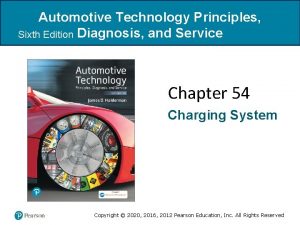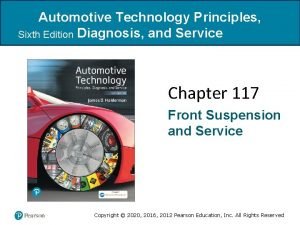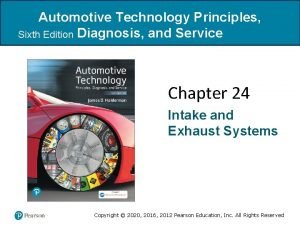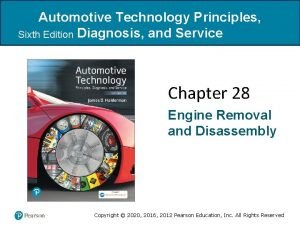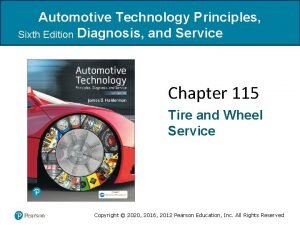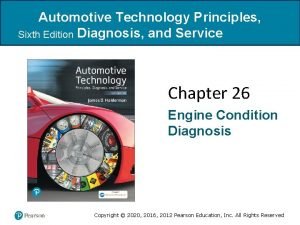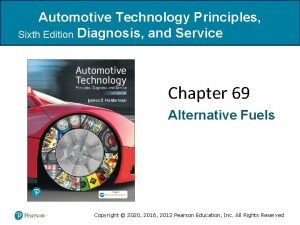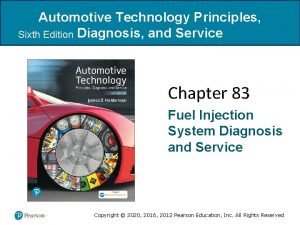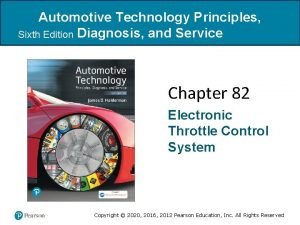Automotive Technology Principles Sixth Edition Diagnosis and Service
































- Slides: 32

Automotive Technology Principles, Sixth Edition Diagnosis, and Service Chapter 11 Vehicle Lifting and Hoisting Copyright © 2018, 2015, 2011 Pearson Education, Inc. All Rights Reserved Copyright © 2020, 2016, 2012 Pearson Education, Inc. All Rights Reserved

LEARNING OBJECTIVES 11. 1 Discuss the purpose of floor jacks and creepers. 11. 2. Describe vehicle hoists and drive-on ramps, and discuss the proper methods for safely hoisting a vehicle. Copyright © 2020, 2016, 2012 Pearson Education, Inc. All Rights Reserved

Floor Jack • A hand operated hydraulic device used for lifting vehicles or components. • Uses four casters to move easily • Not designed to hold a load • Requires the use of jack stands Copyright © 2020, 2016, 2012 Pearson Education, Inc. All Rights Reserved

Figure 11. 1 A hydraulic hand-operated floor jack Copyright © 2020, 2016, 2012 Pearson Education, Inc. All Rights Reserved

Figure 11. 2 Safety stands are being used to support the rear of this vehicle Copyright © 2020, 2016, 2012 Pearson Education, Inc. All Rights Reserved

QUESTION 1: ? What must be used after lifting a vehicle with a floor jack? Copyright © 2020, 2016, 2012 Pearson Education, Inc. All Rights Reserved

ANSWER 1: Jack Stands. Copyright © 2020, 2016, 2012 Pearson Education, Inc. All Rights Reserved

CREEPERS • Use by technician to maneuver under vehicle. • Flat or concaved surface equipped with low profile casters. • Should be stored vertically against wall or toolbox to avoid trip hazards. Copyright © 2020, 2016, 2012 Pearson Education, Inc. All Rights Reserved

VEHICLE HOISTS • In-ground: pneumatic/hydraulic. • Above-ground: electric/hydraulic. • Symmetrical: Equal length lift arms. • Asymmetrical: Unequal length lift arms. • Use recommended vehicle lift points. • Lower onto mechanical locks before working. • Before lowering ensure proper clearances. Copyright © 2020, 2016, 2012 Pearson Education, Inc. All Rights Reserved

Figure 11. 3 Most newer vehicles have a triangular symbol indicating the recommended hoisting lift points Copyright © 2020, 2016, 2012 Pearson Education, Inc. All Rights Reserved

Figure 11. 4 (a) Tall safety stands can be used to provide additional support for a vehicle while on a hoist. (b) A block of wood should be used to avoid the possibility of doing damage to components supported by the stand Copyright © 2020, 2016, 2012 Pearson Education, Inc. All Rights Reserved

Figure 11. 5 This training vehicle fell from the hoist when the pads were not set correctly. No one was hurt, but the vehicle was damaged Copyright © 2020, 2016, 2012 Pearson Education, Inc. All Rights Reserved

Figure 11. 6 (a) An assortment of hoist pad adapters that are often necessary to safely hoist many pickup trucks, vans, and sport utility vehicles. (b) A view from underneath a Chevrolet pickup truck showing how the pad extensions are used to attach the hoist lifting pad to contact the frame Copyright © 2020, 2016, 2012 Pearson Education, Inc. All Rights Reserved

Figure 11. 7 (a) In this photo, the pad arm is just contacting the rocker panel of the vehicle. (b) This photo shows what can occur if the technician places the pad too far inward underneath the vehicle. The arm of the hoist has dented in the rocker panel Copyright © 2020, 2016, 2012 Pearson Education, Inc. All Rights Reserved

QUESTION 2: ? Before working on a vehicle that is on a hoist, what must be done? Copyright © 2020, 2016, 2012 Pearson Education, Inc. All Rights Reserved

ANSWER 2: Lower the vehicle onto the mechanical locks. Copyright © 2020, 2016, 2012 Pearson Education, Inc. All Rights Reserved

DRIVE-ON RAMPS • Inexpensive way to raise the front or rear of the vehicle. • Ramps store easily. • Caution must be used when placing the vehicle on the ramps. • Wheels on the ground need to be blocked to prevent movement. Copyright © 2020, 2016, 2012 Pearson Education, Inc. All Rights Reserved

Figure 11. 8 Drive-on-type ramps. The wheels on the ground level must be chocked (blocked) to prevent accidental movement down the ramp Copyright © 2020, 2016, 2012 Pearson Education, Inc. All Rights Reserved

HOISTING THE VEHICLE Copyright © 2020, 2016, 2012 Pearson Education, Inc. All Rights Reserved

The first step in hoisting a vehicle is to properly align the vehicle in the center of the stall. Copyright © 2020, 2016, 2012 Pearson Education, Inc. All Rights Reserved

Most vehicles will be correctly positioned when the left front tire is centered on the tire pad. Copyright © 2020, 2016, 2012 Pearson Education, Inc. All Rights Reserved

The arms can be moved in and out and most pads can be rotated to allow for many different types of vehicle construction. Copyright © 2020, 2016, 2012 Pearson Education, Inc. All Rights Reserved

Most lifts are equipped with short pad extensions that are often necessary to use to allow the pad to contact the frame of a vehicle without causing the arm of the lift to hit and damage parts of the body. Copyright © 2020, 2016, 2012 Pearson Education, Inc. All Rights Reserved

Tall pad extensions can also be used to gain access to the frame of a vehicle. This position is needed to safely hoist many pickup trucks, vans, and sport utility vehicles. Copyright © 2020, 2016, 2012 Pearson Education, Inc. All Rights Reserved

An additional extension may be necessary to hoist a truck or van equipped with running boards to give the necessary clearance. Copyright © 2020, 2016, 2012 Pearson Education, Inc. All Rights Reserved

Position the pads under the vehicle in the recommended locations. Copyright © 2020, 2016, 2012 Pearson Education, Inc. All Rights Reserved

After being sure all pads are correctly positioned, use the electromechanical controls to raise the vehicle. Copyright © 2020, 2016, 2012 Pearson Education, Inc. All Rights Reserved

With the vehicle raised one foot (30 cm) off the ground, push down on the vehicle to check to see if it is stable on the pads. If the vehicle rocks, lower the vehicle and reset the pads. The vehicle can be raised to any desired working level. Be sure the safety mechanism is engaged before working on or under the vehicle. Copyright © 2020, 2016, 2012 Pearson Education, Inc. All Rights Reserved

If raising a vehicle without a frame, place the flat pads under the pinch weld seam to spread the load. If additional clearance is necessary, the pads can be raised as shown. Copyright © 2020, 2016, 2012 Pearson Education, Inc. All Rights Reserved

When the service work is completed, the hoist should be raised slightly and the safety mechanism released before using the hydraulics to lower the vehicle. Copyright © 2020, 2016, 2012 Pearson Education, Inc. All Rights Reserved

After lowering the vehicle, be sure all arms of the lift are moved out of the way before driving the vehicle out of the work stall. Copyright © 2020, 2016, 2012 Pearson Education, Inc. All Rights Reserved

Copyright © 2020, 2016, 2012 Pearson Education, Inc. All Rights Reserved
 Automotive technology sixth edition
Automotive technology sixth edition Automotive technology sixth edition
Automotive technology sixth edition Principles of economics sixth edition
Principles of economics sixth edition Mmodation
Mmodation The sixth sick sheik's sixth sheep's sick lyrics
The sixth sick sheik's sixth sheep's sick lyrics Automotive heating and air conditioning 8th edition
Automotive heating and air conditioning 8th edition Biochemistry sixth edition
Biochemistry sixth edition Automotive engines 8th edition
Automotive engines 8th edition China automotive technology & research center
China automotive technology & research center Computer architecture a quantitative approach sixth edition
Computer architecture a quantitative approach sixth edition Apa sixth edition
Apa sixth edition Computer architecture a quantitative approach sixth edition
Computer architecture a quantitative approach sixth edition Precalculus sixth edition
Precalculus sixth edition Computer architecture a quantitative approach sixth edition
Computer architecture a quantitative approach sixth edition Independent nursing interventions
Independent nursing interventions Medical diagnosis and nursing diagnosis difference
Medical diagnosis and nursing diagnosis difference Types of nursing diagnosis
Types of nursing diagnosis Objectives of nursing process
Objectives of nursing process Modern automotive technology answer key
Modern automotive technology answer key Emission control system components
Emission control system components Mechanical technology automotive grade 11
Mechanical technology automotive grade 11 Bob caat
Bob caat Mechanical technology automotive grade 10
Mechanical technology automotive grade 10 Sixth sense technology seminar report
Sixth sense technology seminar report Sixth sense technology seminar
Sixth sense technology seminar Sixth sense ted
Sixth sense ted Perbedaan diagnosis gizi dan diagnosis medis
Perbedaan diagnosis gizi dan diagnosis medis Chapter 81 brake system diagnosis service and repair
Chapter 81 brake system diagnosis service and repair Using mis (10th edition) 10th edition
Using mis (10th edition) 10th edition Using mis (10th edition)
Using mis (10th edition) Computer security principles and practice
Computer security principles and practice Computer security principles and practice 4th edition
Computer security principles and practice 4th edition Expert systems: principles and programming, fourth edition
Expert systems: principles and programming, fourth edition





